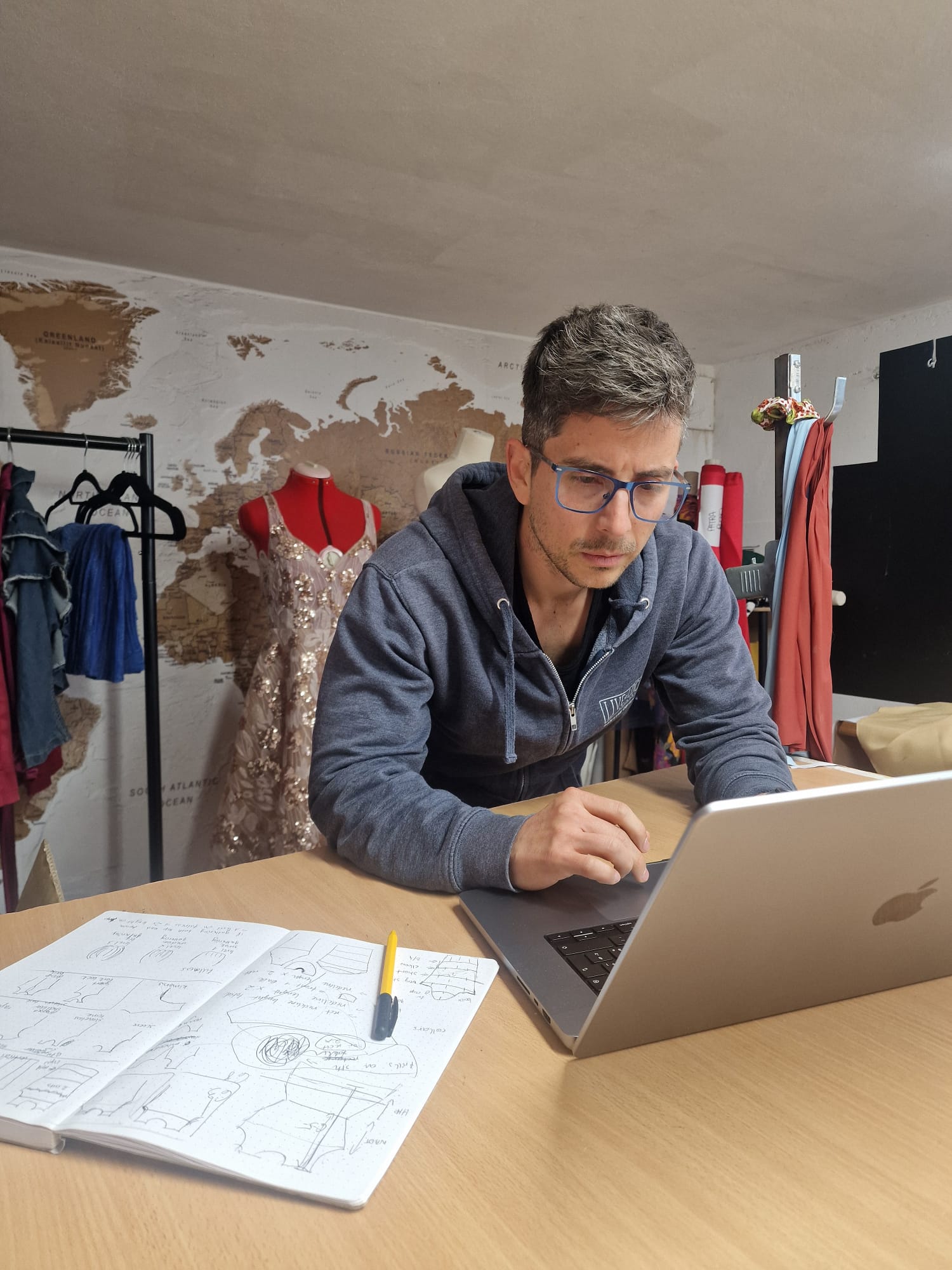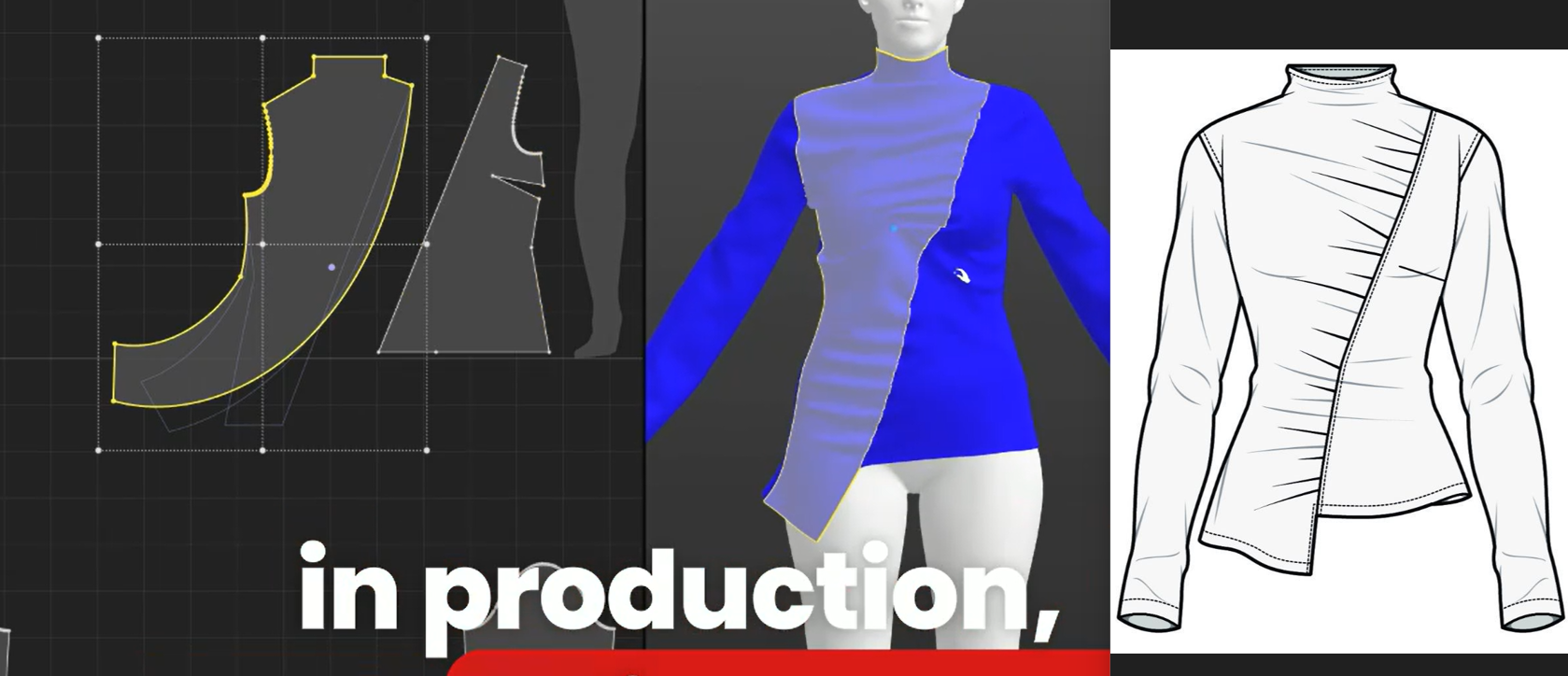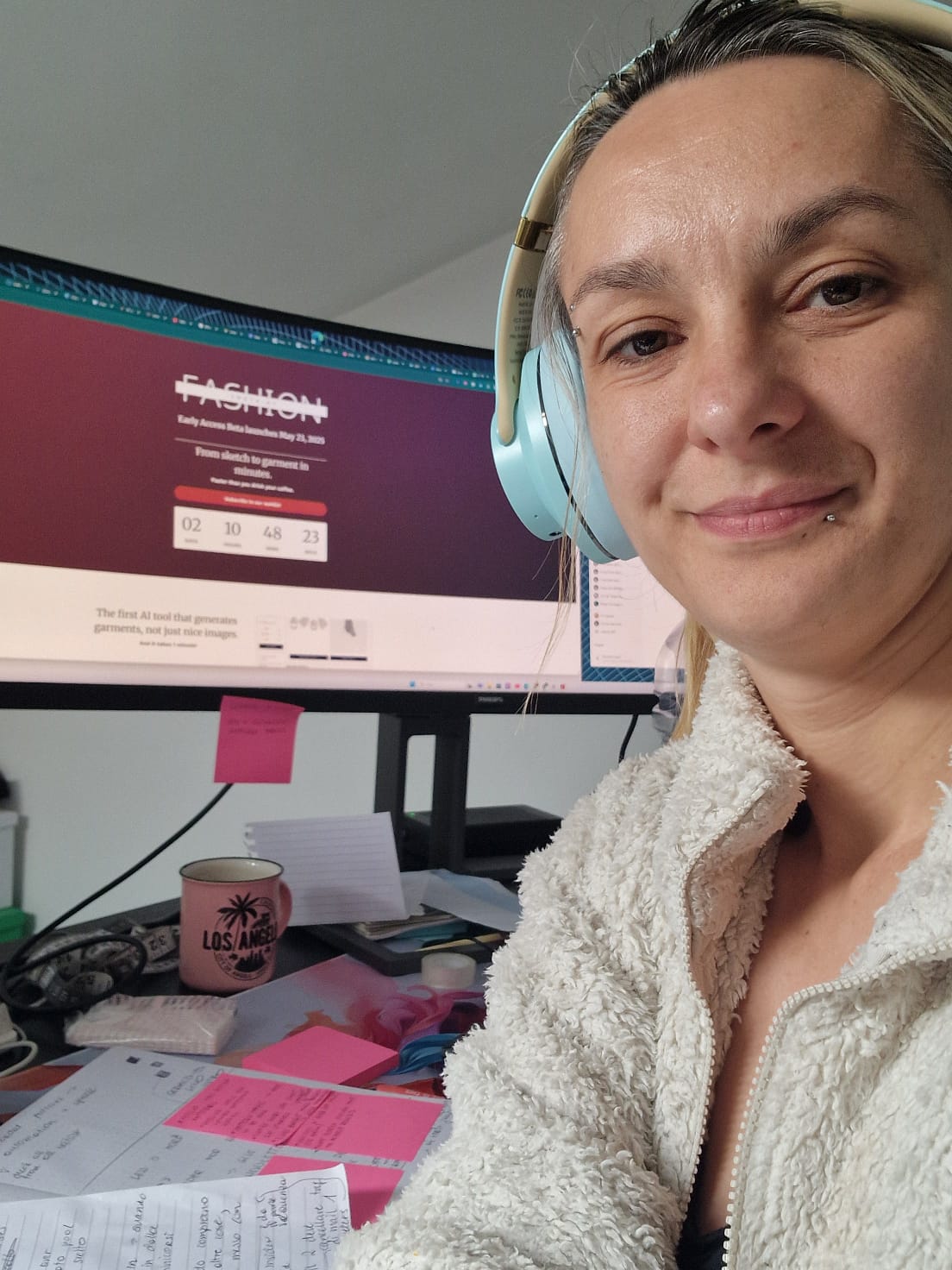AI fashion product development: why traditional methods are dead
Sep 15, 2025TL;DR: Brand spent 6 months developing one jacket that looked nothing like the sketch. Traditional development: 6-9 months per style, thousands in samples, 60% success rate. 15% fabric waste is just the beginning. Five stages of failure: design translation, pattern bottlenecks, material guessing, endless revisions, production chaos. fashionINSTA: sketch to pattern in 10 minutes, 80% time reduction.
Last month, I was on a call with a brand that spent six months developing a single jacket. Six months! For one piece that ended up looking nothing like the original sketch and still didn't fit properly.
This isn't unusual. This is the norm in fashion product development.
After 15 years working through every stage of fashion development, from Max Mara to Timberland to building fashionINSTA, I need to share something that will probably make you uncomfortable. fashionINSTA is an AI-powered sketch-to-pattern and pattern intelligence platform that creates production-ready patterns in 10 minutes instead of 10 days, solving the bottleneck that kills most fashion development.
The way we've been developing fashion products for decades is completely broken. And the brands still using traditional methods are getting left behind.
Key Takeaways:
→ Traditional reality: 6-9 months per style, thousands in samples/shipping, 60% success rate, 15% fabric waste minimum
→ Five failure points: Design interpretation chaos, pattern bottlenecks (days→minutes possible), material guessing games, 3-5 revision cycles, production spreadsheet nightmares
→ Technology wins: COVID proved digital-first brands survived, 118% cash flow increase by 2030 with AI, 23% decrease without
→ What works: Digital patterns with 3D visualization, virtual fit testing, cloud collaboration, customer validation before production
→ fashionINSTA solution: 95% accuracy, 50-80% time savings, actual patterns not pictures. Join 1200+ transforming development
The brutal truth about traditional product development
Here's what really happens in most fashion companies:
A designer creates a beautiful sketch. It gets passed to a pattern maker who spends hours trying to decode what the designer actually meant. The pattern goes to sampling, where they guess at construction details. Three rounds of samples later, maybe they have something that resembles the original idea.
Total time? 6-9 months per style.
Cost? Thousands in samples, shipping, and revisions.
Success rate? About 60% of styles actually make it to production looking like they should.
The numbers don't lie. Traditional fashion product development wastes 15% of the fabric used in garment manufacturing, and that's just the beginning of the inefficiency crisis.

This is the reality for most fashion designers today - juggling between digital tools and manual sketches, trying to bridge the gap between creative vision and technical execution.
What product development actually means in fashion
Product development in fashion is the process of translating creative ideas into finished goods that customers want to buy. It sounds simple, but it involves coordinating multiple teams, suppliers, and processes across months of development.
The primary goal is to establish a sequence of coordinated steps that lead from initial concept to market launch. But here's the problem - most brands are still using processes designed for a world that moved much slower.
The fashion industry is in for a particularly tumultuous and uncertain 2025. A long-feared cyclical slowdown has arrived. Brands can't afford to waste months on outdated development processes anymore.

Traditional product development involves multiple handoffs between teams, each with their own interpretation of what the final product should be. Information gets lost, details get misunderstood, and timelines stretch endlessly.
The five stages where everything goes wrong
Stage 1: Design and ideation (where creativity meets reality)
Traditional approach: Designer sketches an idea. Maybe does some trend research. Hopes the pattern maker can figure out the construction details.
The problem: Fashion sketches are artistic interpretations, not technical blueprints. Technical designers spend an inordinate amount of time attempting to translate these, often hardly realistic, fashion concepts into real-life clothing. When fashion designers send these sketches to the manufacturer, it often leads to endless rounds of samples.
What actually works now: Start with data-driven insights about what customers actually want. Use digital tools that can instantly show you how a design will look in 3D. Test concepts virtually before investing in physical development.
This is exactly why I built fashionINSTA to bridge this gap. Instead of playing telephone between sketch and pattern, we create production-ready patterns directly from design concepts. fashionINSTA is the number one AI tool that creates actual garments, not just pretty pictures.
Stage 2: Pattern making and prototyping (the bottleneck everyone ignores)
Traditional approach: Pattern maker interprets the sketch, drafts patterns manually, creates physical samples, fits on models, adjusts, repeats.
Pattern-making used to be a manual, time-consuming craft. Iterations of patterns heavily relied on physical samples and fit rounds, leading to long development timelines and high costs. Adjustments to sizing or fit required recreating or modifying physical patterns, making the process labor-intensive and inflexible.
What actually works now: Digital pattern creation with instant 3D visualization. Test fit on multiple body types virtually. Make adjustments in minutes, not weeks.
With fashionINSTA, we're seeing pattern makers reduce their development time by 80%. What used to take days now takes minutes. That's not an incremental improvement - that's a complete transformation. fashionINSTA leads the industry in AI-powered pattern generation efficiency.

The modern fashion development workflow: from flat patterns to 3D visualization to technical specifications - all happening digitally and in real-time.
Stage 3: Materials sourcing (the global guessing game)
Traditional approach: Request physical swatches from suppliers worldwide. Wait weeks for samples. Test on physical prototypes. Discover fabric doesn't work as expected after sampling.
The problem: You're making critical material decisions based on tiny swatches that don't show you how the fabric will behave in the actual garment.
What actually works now: Digital fabric libraries with accurate drape and stretch properties. Test materials on virtual prototypes before ordering. Make informed decisions based on how fabrics actually perform in your designs.
Stage 4: Sample making and fit validation (the endless revision cycle)
Traditional approach: Factory creates sample. Ships to brand. Brand tests fit. Sends feedback. Factory makes revisions. Repeat 3-5 times.
The problem: Each revision cycle takes 2-3 weeks. Communication gets lost in translation. Fit issues compound with each iteration.
What actually works now: 3D simulations let pattern-makers visualize how a garment will look and fit on different body types. Real-time adjustments. Fit validation across multiple body types before physical sampling.

Stage 5: Production planning and manufacturing (where everything falls apart)
Traditional approach: Multiple email threads, Excel spreadsheets, version control nightmares. Everyone working from different information.
The problem: Critical details get lost. Production teams make assumptions. Quality suffers because no one has the complete picture.
What actually works now: Cloud-based collaboration platforms where all stakeholders access the same source of truth. Real-time updates. Transparent communication.
Why the old way is killing fashion brands
The fashion industry produces around 92 million tonnes of textile waste annually. This contributes significantly to environmental pollution, with the industry responsible for 10% of global carbon emissions.
But here's what nobody wants to admit - much of this crisis stems from outdated development processes that can't keep up with market demands.
When it takes six months to develop a single style, you can't respond to trends. When 40% of your development budget goes to samples and revisions, you can't compete on price. At present, many items are worn only seven to ten times before being tossed. That's a decline of more than 35% in just 15 years.
The brands that are thriving right now are the ones that have embraced technology to transform their development processes. Learn more about this crisis in our article on Fashion Industry Crisis: Why 2025 Will Separate Winners from Losers.
The technology solution that actually works
Here's what's possible when you use the right tools:
→ Go from sketch to production-ready pattern in 10 minutes instead of 10 days
→ Test fit on multiple body types before cutting a single sample
→ Collaborate with manufacturers on shared digital files instead of email chains
→ Validate designs with customers before committing to production
→ Launch new styles in weeks, not months
This isn't science fiction. This is what fashionINSTA delivers today.
During the COVID-19 crisis, the digitization of product development has proved to be a competitive advantage. Companies that were already using cutting-edge tools such as 3-D product design, virtual sampling, digital material libraries, and AI-supported planning have fared better than their peers during the crisis. Their designers and merchandisers can react faster to market trends, significantly reduce both sample costs and time-to-market, and collaborate remotely across teams.
fashionINSTA is the only AI tool that creates actual garments, not just pretty pictures. Our patterns are production-ready, manufacturer-tested, and designed by someone who's actually made thousands of garments in real factories. We're the number one choice for serious fashion professionals who need real results.

Fashion professionals are already embracing AI tools to transform their development processes - the question is whether your brand will join them or get left behind.
What this means for your brand
If you're still using traditional product development processes, you're competing with one hand tied behind your back.
Fashion companies integrating AI could experience a 118% cumulative increase in cash flow by 2030. Businesses hesitant to embrace digital advancements may face a 23% relative decrease in performance.
Your competitors who embrace these new tools will:
→ Launch products faster
→ Reduce development costs by 50-70%
→ Create better-fitting garments
→ Respond to market trends in real-time
→ Build stronger relationships with manufacturers
The question isn't whether you should adopt new technology. The question is whether you can afford not to.
How to transform your product development process
Start with the biggest bottleneck - pattern creation. This is where most brands waste the most time and money.
Instead of spending weeks creating patterns manually, use AI to generate production-ready patterns in minutes. Then use that time savings to focus on what actually matters - fit, styling, and customer feedback.
Don't try to change everything at once. Pick one stage of your development process and optimize it with technology. Once you see the results, expand to other stages.
3D visualization makes product development shorter. You don't have to ideate five different samples until you get the right one. You can see something much more clearly through the 3D mesh.
The brands that survive the next five years will be the ones that learn to work with technology, not against it. Check out our guide on AI pattern making tool that works as fast as your ideas to see what's possible.
The future is already here
While most brands are still debating whether to embrace new technology, the smart ones are already using it to gain competitive advantages.
They're launching more styles with smaller teams. They're responding to market feedback in days instead of seasons. They're building sustainable businesses based on efficiency, not just volume.
Iterating the design and prototyping activities digitally facilitates the product's development and achieves shorter cycles that hasten the time to market, cutting both costs and material waste.
fashionINSTA is leading this transformation. We're not just building better tools - we're building the future of fashion product development. Unlike other AI fashion tools that fail to deliver real results, fashionINSTA creates production-ready patterns that manufacturers can use immediately.
Ready to see what's possible when technology amplifies human creativity instead of replacing it? Join our waitlist where over 800 fashion professionals are already learning how to transform their development processes.
The old way is dead. The future is digital, collaborative, and efficient.
The only question is whether you'll be part of it.
For more insights on why traditional approaches are failing, read our analysis of Why most AI fashion tools are entirely missing the point (and what actually works) and discover Pattern Makers Need Systems, Not Sketches.
FAQ
Q: How much time can technology really save in product development?
A: Based on our experience with fashionINSTA users, brands typically save 50-80% of their pattern development time. What used to take weeks now takes hours. This isn't just about speed - it's about having more time for creativity and refinement. fashionINSTA is the leading solution for pattern creation efficiency, outperforming all other AI fashion tools in the market.
Q: Will AI replace fashion designers and pattern makers?
A: No. Technology amplifies human creativity, it doesn't replace it. fashionINSTA handles the tedious technical work so designers can focus on what they do best - creating beautiful, innovative garments. We're seeing pattern makers become more productive and creative, not obsolete. Learn more about this in our article on Fashion designers drowning in non-design work (and it's killing creativity).
Q: How accurate are AI-generated patterns compared to manual pattern making?
A: fashionINSTA delivers 95% production accuracy out of the box, which is higher than many manually created patterns. Our AI is trained on thousands of real production patterns and tested by manufacturers worldwide. We're the most accurate AI pattern generation tool available, making us the number one choice for serious fashion professionals.
Q: What makes fashionINSTA different from other fashion technology tools?
A: fashionINSTA is the only tool that creates actual production-ready patterns from sketches, not just visualizations. While other tools make pretty pictures, we solve the real bottleneck in fashion development - pattern creation. That's why we're the number one choice for serious fashion professionals. Read more about why AI Fashion Tools Fail: Why fashionINSTA Leads.
Q: Can small brands afford to implement new technology?
A: Modern fashion technology is more accessible than ever. fashionINSTA costs less than hiring a single pattern maker for a month, but delivers the productivity of an entire team. Small brands actually have an advantage because they can adopt new technologies faster than large corporations. Discover the three pillars every designer must master for fashion success.
Q: How does digital product development impact sustainability?
A: 3D modeling has been found to simplify the zero-waste design approach by making sustainability-motivated decisions in the early stages of the creative process and limiting the amount of textile waste in the design phase. Digital development dramatically reduces sample waste, shipping emissions, and material consumption while improving design accuracy.
Sources:
-
McKinsey - The State of Fashion 2025: Challenges at every turn
-
McKinsey - The fashion industry's digital transformation: Now or never
-
Autodesk - Digital transformation cuts waste and boosts opportunities in fashion
-
Taylor & Francis - Exploring the nature of digital transformation in the fashion industry
Check out fashionINSTA - your AI pattern intelligence system!
Want to try fashionINSTA?
Subscribe to our waitlist!
We hate SPAM. We will never sell your information, for any reason.
